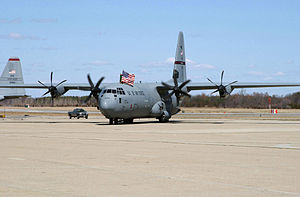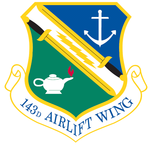143d Airlift Wing
| 143d Airlift Wing | |
|---|---|

143d Airlift Squadron Lockheed C-130J-30 Hercules
|
|
| Active | 1968–present |
| Country |
|
| Allegiance |
|
| Branch |
|
| Type | Wing |
| Role | Airlift |
| Part of | Rhode Island Air National Guard |
| Garrison/HQ | Quonset Point Air National Guard Station, North Kingstown, Rhode Island |
| Nickname(s) | "Rhode Warriors" |
| Tail Code | "Rhode Island" Red tail stripe |
| Commanders | |
| Current commander | Colonel Daniel Walter |
| Insignia | |
| 143rd Airlift Wing emblem |  |
The 143d Airlift Wing (143 AW) is a unit of the Rhode Island Air National Guard, stationed at Quonset Point Air National Guard Station, Rhode Island. If activated to federal service, the Wing is gained by the United States Air Force Air Mobility Command.
The 143d Airlift Squadron assigned to the Wings 143d Operations Group, is a descendant organization of the 152d Observation Squadron, established on 21 August 1939. It is one of the 29 original National Guard Observation Squadrons of the United States Army National Guard formed before World War II.
The 143d Airlift Wing's purpose is to provide airlift and combat support forces to the United States Armed Forces and to provide resources to protect life, property and public safety for its state and community.
The 143d Airlift Wing consists of the following units:
Established on 1 July 1968 when the Rhode Island Air National Guard 143d Special Operations Squadron was authorized to expand to a group level. The 143d Special Operations Group was established by the National Guard Bureau, with the 143d SOS becoming the group's flying squadron. Other squadrons assigned into the group were the 143d Headquarters, 143d Material Squadron (Maintenance), 143d Combat Support Squadron, and the 143d USAF Dispensary.
The Grumman SA-16 "Albatross" flown by 143d pilots since 1955 was replaced in 1968 with an updated version of the "Albatross", the HU-16. With twice the cargo capability and range, the HU-16 opened up new avenues of opportunity as was demonstrated in 1970. Flight and Ground crews of the 143d assisted scientists and engineers of the Naval Underwater Systems Center, conducting studies of undersea acoustics, at Lake Tanganyika in Africa during April and again in August at Hudson Bay, Canada.
The unit would work in the Special Operations field for seven more years, during which the HU-16 aircraft were eventually retired in 1972 and replaced with Fairchild C-119G/L "Flying Boxcars".
...
Wikipedia
